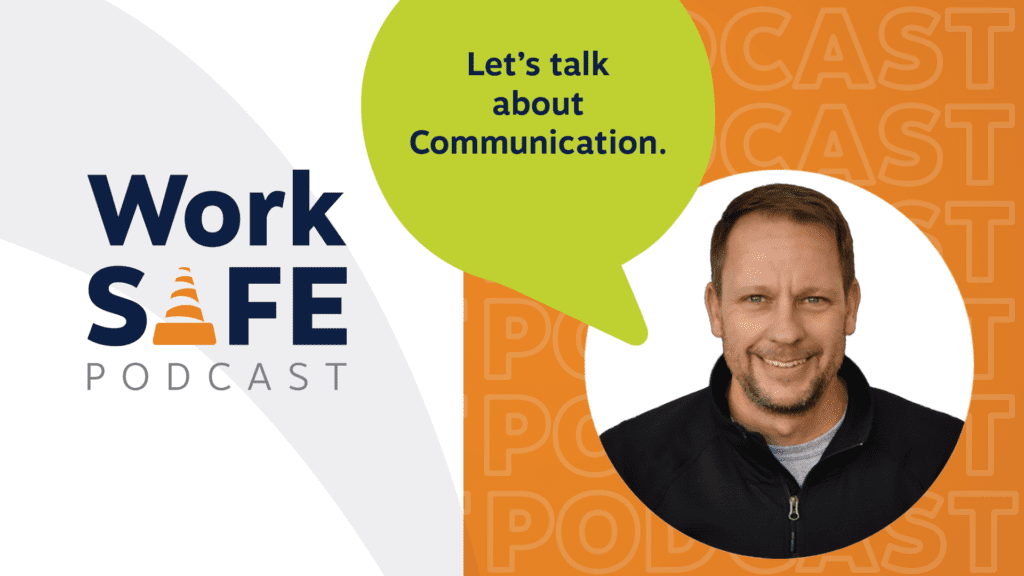On this episode of the WorkSAFE Podcast, we sit down with Blaine Hoffmann, host of the Safety Pro Podcast. He’s been working to keep people safe since 1992, and helping businesses keep their employees safe for nearly 20 years. Blaine is the author of the recently published book, Rethinking Safety Communications, where he details effective communication strategies for sharing safety with diverse audiences.
In today’s workplace, safety isn’t considered a “sexy” topic. It can’t always compete with the excitement of meeting production numbers ahead of schedule, the escape of an off-site teambuilding activity, or the buzzy buildup of year-end bonuses. Some employers consider safety communication challenging, unengaging, and not always very impactful. What if there was a better way to engage employees?

Listen to this episode of the WorkSAFE Podcast, or read the show notes below.
Speaking in a language everyone understands
For Hoffmann, one of the biggest struggles for employers and safety professionals alike is converting their expertise into something employees can understand. It’s easy to use jargon and unfamiliar safety terms when trying to train someone. But not everyone knows what they mean. As a result, listeners can miss key points in a safety message and disengage from important information. “We need to be speaking their language,” he explained.
Safety competes with other priorities
In many companies, safety is a competing priority with other focuses, like productivity, product quality, or staying within a budget. Hoffmann highlights that it’s important to change this concept. “‘I have to get this work done, but then I have to have to follow these safety rules’,” he offered as an example. “The worker thinks that they’re competing, and they’re not. Safety is a tool that we’re going to use, like all of our other tools, to help us get the job done.”

Safety communication: Create a strategy
Great safety communication means prioritizing what people need to know and getting that information to them in an effective way. Hoffmann points out that facts and figures don’t help employees on the job. Straightforward information does. Hoffmann recommends taking a few key steps to determine how to best communicate with your employees.
Identify communication channels
Are texts and emails the best way to reach employees? If phones or computers aren’t allowed in a work area, what methods do you have to share information in that place? Would digital boards or posters in a communal space present a better opportunity? List all of the ways you can communicate with an employee. Big or small, each communication channel presents an opportunity to provide safety information.
Scale and frame your message
Whether it’s a policy, training, or tidbit of information, match each item to the appropriate communication channel and its importance. Hoffmann identifies this as ‘framing’ and ‘scaling’. For example, a required full-day training is important for employees to attend. A direct email send to every employee inbox may be the best way to inform them.
In comparison, employees may need a daily reminder to wear gloves or goggles when entering a work area. Sending a reminder email every day would be both frustrating and eventually ineffective, as employees might start to ignore them. But a poster or sticker is a great opportunity to share a reminder as people pass in and out of the space.
Practice and improve over time
Although it may take a little practice, Hoffmann emphasizes that it’s important to match the message to the right communication method. “All these little things have to kind of work together in order for us to succeed. And that’s where I think as safety professionals, we often fail,” he shared.
“We say, ‘I have this thing and I know exactly how I would say it. I just need them to hear it.'” As a result, the same message is copied and pasted into an email, printed on a poster, and texted across the company. “One message, one way, and then check the box that I told them.”
Choosing to do safety communication differently
Regulatory guidelines often require that employees learn certain information. However, employers often have leeway in the way they present it. Compliance doesn’t have to mean ‘boring’ or ‘uneventful’.
“We can make it engaging, we can make it fun. We could do as much hands-on as we can, in person as we can, because we know that that’s going to stick, right?” Hoffmann pointed out. “That’s going to make it sticky. It’s going to increase retention. They’re going to remember it. And it’s going to be a positive experience.”

The power of storytelling
People are receptive to stories. Whether it’s movies, podcasts, or multi-part tales shared on TikTok or YouTube, we become invested in a great story and lock into learning the outcome. Hoffmann points out that common workplace incidents are stories in and of themselves. Anyone can relate to a slip, fall, or near miss. There are inciting incidents and consequences to understand.
Rather than reprimanding employees after an incident, or doubling down on surveillance, share the lessons learned in the form of a story. Soliciting feedback after sharing them is even better. Not only do employees understand the context and outcome, but they then have room to share their own experiences and takeaways.
“You want to focus on ‘Here’s what we learned’, ‘What do you think?’ So two-way communication,” he explained. “If it’s just one way, you’re talking at people and instructing them, and you’re not getting feedback. That could fall flat sometimes.”
Safety communication: Getting leadership buy-in
Leaders are often a critical part of how safety communication is perceived in a workplace. If they don’t buy into it, then employees won’t either. But for Hoffmann, safety communication simply has to be presented in a way they can understand. “Senior leaders, managers, they’re people too,” he said. “They’re no different than anybody else. We’re all in the same boat here with this, with communications.”
No one enjoys hearing about someone who became ill or was injured on the job. Further, most leaders want to prevent that. For someone managing resources or budgets, they need to know how the decisions they make can facilitate change.
“I need to be able to talk in their terms and, you know, using numbers, data statistics, or whatever will motivate them,” he added. “A little bit of storytelling in there to get them to approve, or get them to support whatever it is I’m trying to get them to do, whether it’s investing in materials, training, equipment, something like that.”
Making changes today
Employers should use the resources they have at their fingertips to help customize their safety communication. For some companies, this may look like tapping into a marketing team or in-house safety professionals. For others, Google or YouTube may be easier to access and more cost-efficient. Any company can tap into local organizations or connect with other business owners to share ideas.
Hoffmann points out that smaller companies, even ones that lack capital and extensive resources, have an advantage over larger ones. “The advantage they have that large companies don’t is that I can often get everybody in the company into one area, into one spot at one time,” he pointed out. The further a safety message needs to reach, the more intentional employers have to be about reaching every shift and work location.
At the end of the day, there’s no hidden secret to safety communication. “It’s really just learning. You’re not going to be able to shortcut this – there’s no hack for it,” Hoffmann shared. “If you have to do it, you might as well do it well. You might as well make sure it’s the best you can possibly do. So I just encourage folks to, whether it’s a book, whether it’s YouTube, expose yourself, learn as much as you can about it.”